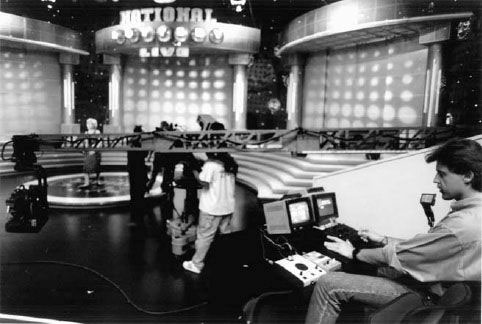Standard camerawork conventions
The technique of changing shot without distracting the audience was learnt over a number of years. Reverse angles, point-of-view shots and position matching on cuts were all discovered and became standard technique. The evolution of the grammar of film technique was not instantaneous or self-evident. Each visual technique had to be invented, refined and accepted by other film makers before entering the repertoire of standard camera practice.
The thread that linked most of these developments was the need to provide a variety of ways of presenting visual information coupled with the need for them to be unobtrusive in their transition from shot to shot. Expertly used, they were invisible and yet provided the narrative with pace, excitement and variety. These criteria are still valid and much of the pioneering work from the first decades of the twentieth century remains intact in current camera technique.
Multi-camera live television conventions
Film is a record of an event, edited and assembled after the event occurs. Live television is a presentation of an event as it occurs. The unique quality of an electronic camera is its ability to produce a picture that can be instantly transmitted. Multi-camera coverage entails a production technique which involves a number of people perfecting their individual contribution in a production group simultaneously as the event is transmitted. To coordinate such a group activity, it is essential to plan and have some measure of rehearsal before transmission or to rely on standard production conventions which are understood by everyone involved.
Standard television multi-camera conventions grew out of film technique and the same objectives of disguising technique in order to suspend disbelief in the viewer was adopted. The problem for live television was not to recreate ‘real’ time as in discontinuous film shooting but to mould multicamera shooting of an event so that, for example, change of camera angle or cutting between different shot sizes was not obtrusive and distracting to the viewer. The aim once again was towards an ‘invisible’ technique.
As multi-camera television camerawork deals with uninterrupted action in a timescale created by the nature of the event covered, ‘real’ time has to be continuously covered in a mixture of shot sizes, camera development and matched shot sizes to allow invisible cuts between cameras.
Multi-camera camera operators have to provide cutting points either prerehearsed or by monitoring what the rest of the camera crew are providing. Idiosyncratic personal composition by a camera operator will remain unnoticed only if he/she is responsible for the whole of the visual production. It will immediately become apparent in multi-camera work if his/her work is intercut with standard camera technique provided by the rest of the crew.

Multi-camera technique remains invisible provided it conforms to certain criteria. These standard conventions are inherited by everyone working within live or multi-camera recordings.
